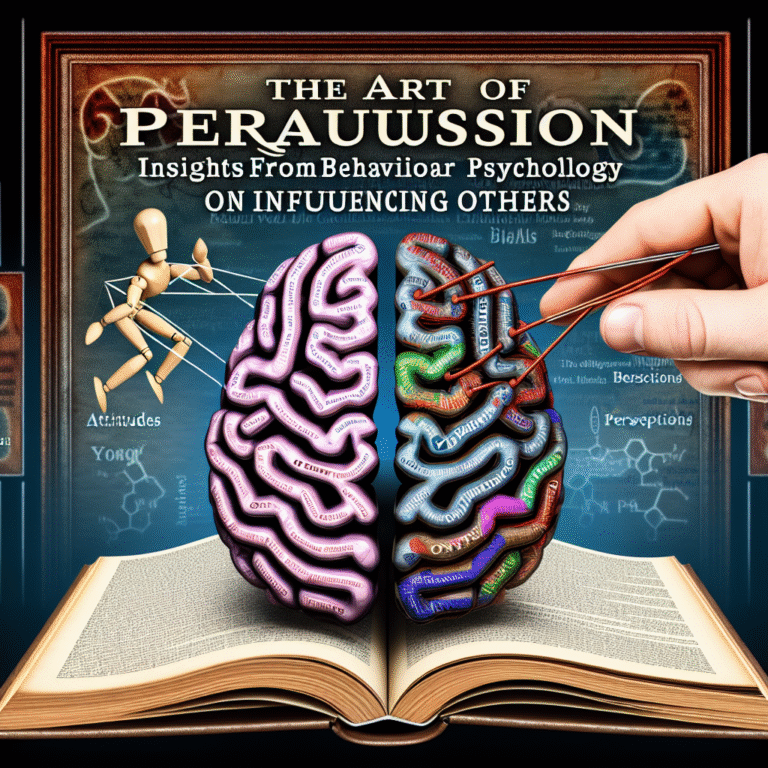
Subliminal Selling: How Behavioral Psychology Impacts Your Shopping Experience
Introduction
Imagine walking into a store and finding yourself irresistibly drawn to a specific product. Is it simply the bright packaging or the friendly smiles from the staff? Or could it be something deeper, a mechanism at play that silently influences your thoughts and choices? Welcome to the captivating world of subliminal selling, where behavioral psychology intricately weaves its influence into your shopping experience. In this article, we will explore how subliminal selling shapes consumer behavior, disrupts decision-making, and ultimately transforms your shopping journey into an intricate dance of choice and persuasion. It’s not just about what you buy; it’s about why you buy it.
Understanding Subliminal Selling
The Psychology Behind Shopping
Behavioral psychology studies how our thoughts, emotions, and social contexts affect our actions. In the realm of shopping, these elements intertwine to create an experience that often feels instinctual. Retailers employ a myriad of strategies, many of which operate below our conscious awareness. By tapping into psychological principles like social proof, scarcity, and anchoring, stores craft environments designed to influence our purchasing behavior.
Subliminal Messaging Explained
At the heart of subliminal selling is the idea that we can be influenced by stimuli that we are unaware of. This can include low-volume audio messages, subtle changes in lighting, or even the scent of a store. For instance, a brand might play soft music to evoke nostalgia or utilize specific colors to associate certain feelings with products. Understanding these nuances is essential for consumers to recognize when their decisions are being swayed.
Case Studies in Subliminal Selling
Case Study 1: The Power of Music
Analysis: A study conducted by researchers at the University of Groningen analyzed the impact of music tempo on retail shopping behavior. Stores that played slower music saw an increase in sales. The shoppers spent more time browsing, allowing for impulse purchases. This experiment shows how the rhythm of music can unconsciously affect shopping decisions.
- Findings: Respondents in slower-tempo environments reported feeling relaxed and were more likely to linger in stores, leading to higher spending.
Case Study 2: The Role of Color
Analysis: A fascinating study published in the journal Management Decision examined how color can influence consumer emotions and decisions. Retailers like Target and IKEA use color schemes strategically to elicit a desired emotional response. For instance, the color red can evoke urgency, prompting quicker purchasing decisions.
- Findings: Brands that align their color schemes with their desired customer experiences tend to outperform their competitors in terms of sales and customer loyalty.
Case Study 3: Scarcity and Urgency
Analysis: When companies employ scarcity (e.g., “Only 2 items left!”), it triggers a fear of missing out (FOMO). A Harvard Business Review article explored how this tactic played a crucial role in the sales strategies of brands like Apple during product launches.
- Findings: Consumers are more likely to purchase products when they feel they might lose out on an opportunity, illustrating how urgency can be a powerful motivator.
The Mechanisms of Subliminal Selling
Social Proof
One of the strongest influences in subliminal selling is social proof—the idea that people are likely to follow the actions of others. You’ve likely experienced this when you see a line outside a restaurant; your mind rationalizes that if many people are willing to wait, the food must be excellent. Retailers use this concept by showcasing customer reviews, ratings, and user-generated content, nudging you closer to making a purchase.
Anchoring Effect
The anchoring effect refers to the tendency to rely heavily on the first piece of information encountered (the "anchor") when making decisions. For example, if a shirt is marked at $100 but suddenly discounted to $60, consumers might perceive it as a "great deal," using the initial price as a mental anchor. Retailers deliberately exploit this psychological bias to create perceived value.
The Scent of Success
Scent marketing is another effective strategy. Research shows that pleasant scents can enhance shoppers’ moods, leading to longer visits and greater sales. For instance, luxury brands often use signature fragrances to evoke feelings of sophistication, ensuring customers associate positive emotions with their products.
| Strategy | Impact | Example |
|---|---|---|
| Music Tempo | Influences shopping duration | Slower music leads to longer stays |
| Color Psychology | Evokes emotional responses | Red for urgency, blue for calmness |
| Scarcity Messaging | Triggers FOMO | “Limited Edition” labels |
| Scent Marketing | Enhances mood, improves sales | Signature scents in high-end retail |
| Social Proof | Encourages purchases | Displaying positive customer testimonials |
Implementing Subliminal Strategies in Consumer Behavior
As consumers, understanding the tactics behind subliminal selling empowers you to make informed decisions about your purchases. This knowledge can lead to more intentional shopping experiences, reducing the risk of impulse buys and ensuring your choices align with your genuine needs and values.
Recognizing Subliminal Selling
- Awareness of Surroundings: Pay attention to factors such as music, layout, and scent when shopping. Reflect on how these elements influence your mood and decisions.
- Questioning Anchors: When faced with a sale, consider whether the original price genuinely reflects the product’s value or if it’s a marketing tactic.
- Evaluating Social Proof: Look for bias in testimonials and reviews; consider seeking diverse opinions beyond what retailers showcase.
Smart Shopping Strategies
- Setting a Budget: Establish a spending limit before entering a store, minimizing the risk of impulsive decisions driven by subliminal messages.
- Making Lists: Prepare a shopping list before you head out to ensure you focus on essential items rather than being swayed by marketing tactics.
- Mindful Shopping: Take time to assess your emotional state as you shop. Are you drawn to a product due to a genuine need or emotional influence from the environment?
Conclusion
Subliminal selling is a fascinating intersection of behavioral psychology and consumer behavior that shapes our shopping experiences in significant ways. By recognizing how subtle cues impact our decisions, we can become more mindful consumers. Understanding subliminal selling not only empowers you to take control of your purchasing decisions but also enhances your shopping experience, turning it from an automatic action into a more conscious and intentional act.
By implementing awareness and strategic thinking in your shopping habits, you can navigate retail environments with confidence, enabling you to make choices that reflect your true preferences and values.
FAQs
What is subliminal selling?
Subliminal selling refers to marketing strategies designed to influence consumers’ purchasing decisions without their conscious awareness. This can involve various sensory inputs, including visuals, sounds, and even scents.
How does behavioral psychology affect shopping?
Behavioral psychology provides insight into how emotions, thoughts, and social contexts influence decision-making and consumer behavior, equipping marketers with strategies to drive sales.
Can subliminal messages really influence choices?
While research varies, there is evidence suggesting that subliminal messages can affect perceptions and decisions, particularly when they tap into existing motivations or emotions.
How can I protect myself from subliminal selling?
To defend against subliminal selling, remain conscious of your shopping environment, evaluate emotional responses to marketing tactics, and be strategic with your purchases.
What should I consider when shopping?
Always consider your budget, stick to a shopping list, and be aware of how sensory elements in stores may impact you. Recognizing these influences can help you shop more mindfully.
By learning how subliminal selling works and how behavioral psychology impacts your shopping experience, you can become a savvy consumer, better equipped to navigate the marketing world with intentionality and confidence.














